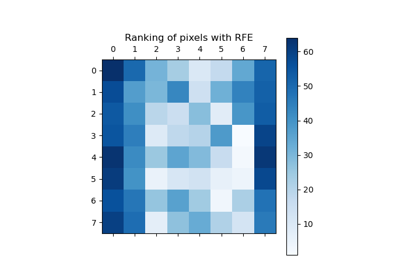-
class sklearn.feature_selection.RFE(estimator, n_features_to_select=None, step=1, verbose=0)[source] -
Feature ranking with recursive feature elimination.
Given an external estimator that assigns weights to features (e.g., the coefficients of a linear model), the goal of recursive feature elimination (RFE) is to select features by recursively considering smaller and smaller sets of features. First, the estimator is trained on the initial set of features and weights are assigned to each one of them. Then, features whose absolute weights are the smallest are pruned from the current set features. That procedure is recursively repeated on the pruned set until the desired number of features to select is eventually reached.
Read more in the User Guide.
Parameters: estimator : object
A supervised learning estimator with a
fitmethod that updates acoef_attribute that holds the fitted parameters. Important features must correspond to high absolute values in thecoef_array.For instance, this is the case for most supervised learning algorithms such as Support Vector Classifiers and Generalized Linear Models from the
svmandlinear_modelmodules.n_features_to_select : int or None (default=None)
The number of features to select. If
None, half of the features are selected.step : int or float, optional (default=1)
If greater than or equal to 1, then
stepcorresponds to the (integer) number of features to remove at each iteration. If within (0.0, 1.0), thenstepcorresponds to the percentage (rounded down) of features to remove at each iteration.verbose : int, default=0
Controls verbosity of output.
Attributes: n_features_ : int
The number of selected features.
support_ : array of shape [n_features]
The mask of selected features.
ranking_ : array of shape [n_features]
The feature ranking, such that
ranking_[i]corresponds to the ranking position of the i-th feature. Selected (i.e., estimated best) features are assigned rank 1.estimator_ : object
The external estimator fit on the reduced dataset.
References
[R167] Guyon, I., Weston, J., Barnhill, S., & Vapnik, V., ?Gene selection for cancer classification using support vector machines?, Mach. Learn., 46(1-3), 389?422, 2002. Examples
The following example shows how to retrieve the 5 right informative features in the Friedman #1 dataset.
>>> from sklearn.datasets import make_friedman1 >>> from sklearn.feature_selection import RFE >>> from sklearn.svm import SVR >>> X, y = make_friedman1(n_samples=50, n_features=10, random_state=0) >>> estimator = SVR(kernel="linear") >>> selector = RFE(estimator, 5, step=1) >>> selector = selector.fit(X, y) >>> selector.support_ array([ True, True, True, True, True, False, False, False, False, False], dtype=bool) >>> selector.ranking_ array([1, 1, 1, 1, 1, 6, 4, 3, 2, 5])Methods
decision_function(\*args, \*\*kwargs)fit(X, y)Fit the RFE model and then the underlying estimator on the selected features. fit_transform(X[, y])Fit to data, then transform it. get_params([deep])Get parameters for this estimator. get_support([indices])Get a mask, or integer index, of the features selected inverse_transform(X)Reverse the transformation operation predict(\*args, \*\*kwargs)Reduce X to the selected features and then predict using the underlying estimator. predict_log_proba(\*args, \*\*kwargs)predict_proba(\*args, \*\*kwargs)score(\*args, \*\*kwargs)Reduce X to the selected features and then return the score of the underlying estimator. set_params(\*\*params)Set the parameters of this estimator. transform(X)Reduce X to the selected features. -
__init__(estimator, n_features_to_select=None, step=1, verbose=0)[source]
-
fit(X, y)[source] -
- Fit the RFE model and then the underlying estimator on the selected
- features.
Parameters: X : {array-like, sparse matrix}, shape = [n_samples, n_features]
The training input samples.
y : array-like, shape = [n_samples]
The target values.
-
fit_transform(X, y=None, **fit_params)[source] -
Fit to data, then transform it.
Fits transformer to X and y with optional parameters fit_params and returns a transformed version of X.
Parameters: X : numpy array of shape [n_samples, n_features]
Training set.
y : numpy array of shape [n_samples]
Target values.
Returns: X_new : numpy array of shape [n_samples, n_features_new]
Transformed array.
-
get_params(deep=True)[source] -
Get parameters for this estimator.
Parameters: deep : boolean, optional
If True, will return the parameters for this estimator and contained subobjects that are estimators.
Returns: params : mapping of string to any
Parameter names mapped to their values.
-
get_support(indices=False)[source] -
Get a mask, or integer index, of the features selected
Parameters: indices : boolean (default False)
If True, the return value will be an array of integers, rather than a boolean mask.
Returns: support : array
An index that selects the retained features from a feature vector. If
indicesis False, this is a boolean array of shape [# input features], in which an element is True iff its corresponding feature is selected for retention. Ifindicesis True, this is an integer array of shape [# output features] whose values are indices into the input feature vector.
-
inverse_transform(X)[source] -
Reverse the transformation operation
Parameters: X : array of shape [n_samples, n_selected_features]
The input samples.
Returns: X_r : array of shape [n_samples, n_original_features]
Xwith columns of zeros inserted where features would have been removed bytransform.
-
predict(*args, **kwargs)[source] -
- Reduce X to the selected features and then predict using the
- underlying estimator.
Parameters: X : array of shape [n_samples, n_features]
The input samples.
Returns: y : array of shape [n_samples]
The predicted target values.
-
score(*args, **kwargs)[source] -
- Reduce X to the selected features and then return the score of the
- underlying estimator.
Parameters: X : array of shape [n_samples, n_features]
The input samples.
y : array of shape [n_samples]
The target values.
-
set_params(**params)[source] -
Set the parameters of this estimator.
The method works on simple estimators as well as on nested objects (such as pipelines). The latter have parameters of the form
<component>__<parameter>so that it?s possible to update each component of a nested object.Returns: self :
-
transform(X)[source] -
Reduce X to the selected features.
Parameters: X : array of shape [n_samples, n_features]
The input samples.
Returns: X_r : array of shape [n_samples, n_selected_features]
The input samples with only the selected features.
-
feature_selection.RFE()
Examples using
2025-01-10 15:47:30

Please login to continue.